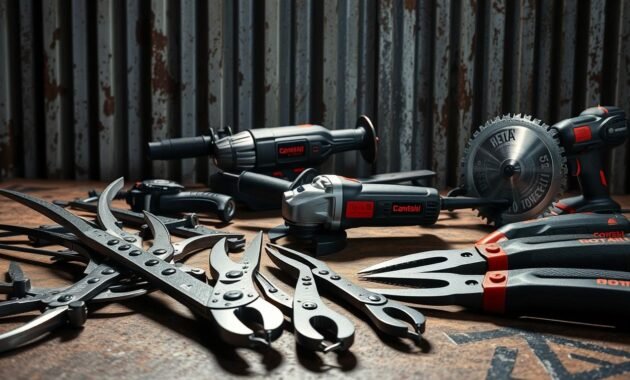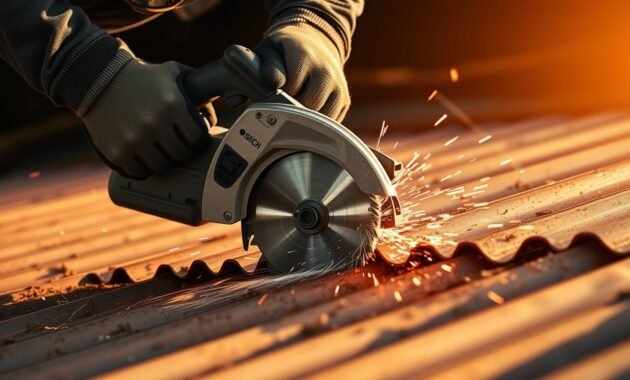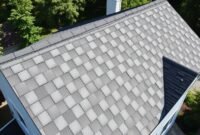Cutting metal roofing can be tough for DIY fans. You might face dull tools, jagged edges, and safety risks. These issues can ruin your home improvement plans.
But there’s a solution! I’ll teach you how to cut metal roofing easily. You’ll save time, money, and avoid headaches. This guide will help you master metal roofing installation.
Raed also: How to Install Metal Roofing on a Shed Easily
Whether you’re updating your roof or working on a big project, knowing how to cut metal roofing is key. You’re about to learn top-notch techniques. These will make your metal roofing project go smoothly.
Understanding Metal Roofing Materials and Their Properties
When you’re cutting metal roofs, knowing your materials is key. Metal roofing sheets vary, each with its own traits. These traits affect how you cut and install them. Let’s dive into the basics you need to know before starting your roofing project.
Types of Metal Roofing Sheets
Roofing metal sheets are made from different materials. Each has its own benefits:
- Steel: The most common metal sheet, making up about 60% of residential roofs
- Aluminum: Great for coastal areas because it doesn’t rust
- Copper: Loved for its beauty, but it’s pricier
- Zinc: Lasts up to 80 years, making it a long-lasting choice
Common Metal Roofing Gauges
| Gauge | Thickness (inches) | Best Used For |
|---|---|---|
| 24 gauge | 0.024 | Residential roofing |
| 26 gauge | 0.019 | Light commercial applications |
| 29 gauge | 0.015 | Agricultural buildings |
Material Characteristics and Cutting Challenges
Each metal sheet has its own cutting challenges. Corrugated metal, for example, needs careful handling to avoid damage. Steel sheets have coatings that must be considered when cutting. Aluminum, being softer, requires precise tools for clean cuts.
Knowing these material traits helps you choose the right tools and methods. This ensures your cuts are professional and high-quality.
Essential Safety Equipment for Metal Roof Cutting
Protecting yourself is key when cutting metal. The right safety gear can prevent accidents. It’s all about power tool safety and personal protective equipment.
Here are the must-haves for metal roof cutting:
- Safety glasses or goggles to protect your eyes from metal shavings
- Cut-resistant work gloves to shield your hands from sharp edges
- Hearing protection to guard against loud power tool noise
- Long-sleeve clothing to prevent metal chip burns
- Steel-toed boots for foot protection
- Hard hat to protect against falling objects
Your safety gear is your first defense. Choose high-quality equipment from trusted brands. Industry stats show 100% of roofing projects need safety gear to avoid accidents.
When choosing gloves, look for cut resistance ratings. Your safety glasses should meet ANSI impact standards. Hearing protection should block at least 20 decibels of noise.
Pro tip: Always check your safety gear before starting. Damaged gear can put you at risk during metal cutting.
Preparation Steps Before Cutting Metal Roofing
Working with metal roofing needs careful planning and precision. As a DIY roofing expert, I know the right prep is key. Before cutting, set up a safe and accurate workspace.
Measuring and Marking Guidelines
Getting the measurements right is vital for metal roofing. Here are the steps for precise cuts:
- Measure the roof area and divide by the panel size to find out how many sheets you need
- Use a high-quality metal measuring tape for accuracy
- Mark cutting lines with a permanent marker or chalk line
- Double-check measurements before cutting to avoid wasting material
Setting Up Your Work Area
Having a good workspace is key for safe metal cutting. Your area should be clean, well-lit, and free from hazards.
| Work Area Requirement | Recommended Setup |
|---|---|
| Surface | Stable workbench or sturdy sawhorses |
| Lighting | Bright, even illumination |
| Space | Minimum 6 feet of clear working area |
| Ventilation | Open area or well-ventilated workspace |
Securing Metal Sheets for Cutting
Securing metal sheets is vital for safe and precise cuts. I always use heavy-duty clamps to keep sheets in place. This method prevents slipping and ensures clean cuts, reducing accident risks.
- Use at least two clamps per metal sheet
- Position clamps to avoid interfering with cutting path
- Check sheet stability before start cutting
- Wear cut-resistant gloves for additional protection
By following these steps, you’ll be ready to tackle your metal roofing project safely and efficiently.
Best Way to Cut Metal Roofing: Tools and Techniques

Choosing the right tools for cutting metal roofing is key to a successful project. As a pro, I’ve learned the best methods for precision and speed. Let me share my insights with you.
Choosing the right tool depends on several things. These include the metal roofing type, its thickness, and the cuts you need. It’s important to think about your project’s specific needs when cutting metal roofing.
- Manual Tin Snips: Ideal for small, precise cuts
- Power Shears: Best for long, straight cuts
- Circular Saws: Great for multiple sheet cutting
- Angle Grinders: Versatile for complex cutting tasks
Always wear protective gear when cutting metal. This includes:
- Safety glasses
- Cut-resistant gloves
- Ear protection
- Long-sleeve clothing
Professional tip: Practice on scrap before making important cuts. This helps you see how tools work with your metal. Some tools are better for certain metals, so test and choose carefully.
For DIYers and pros, good cutting tools save time and avoid mistakes. There are many options available, fitting different skills and needs.
Using Tin Snips for Precise Metal Cuts
Metal roofing needs precision and the right tools for clean cuts. Tin snips are key for accurate cuts in metal roofing. They are versatile and affordable for DIYers and pros alike.
Understanding Tin Snip Varieties
Tin snips have three types for different cutting tasks:
- Yellow-handled snips: Straight cuts (ideal for general cutting)
- Red-handled snips: Left-handed/counterclockwise cuts
- Green-handled snips: Right-handed/clockwise cuts
Mastering Tin Snip Cutting Techniques
To get precise cuts, follow these steps:
- Choose the right tin snips for your cut
- Mark your cut lines carefully
- Wear safety glasses and gloves
- Apply steady pressure while cutting
- Make small cuts for complex shapes
| Tin Snip Type | Best Use | Cutting Direction |
|---|---|---|
| Straight Cuts | Long, straight metal sheets | Direct forward cutting |
| Left Cuts | Counterclockwise curves | Left-side cutting |
| Right Cuts | Clockwise curves | Right-side cutting |
Keep your tin snips in good shape for precise cuts. Clean the blades, oil the pivot, and replace them when dull. By doing this, you’ll get clean, accurate cuts in your metal roofing.
Power Metal Shears: Benefits and Usage
Power metal shears are a big help for big metal roofing jobs. They are much better than cutting by hand. They are a must-have for both pros and DIY fans.
These shears cut metal roofing fast and easy. They can handle thick metal panels that regular tin snips can’t. The main benefits are:
- Faster cutting speeds
- Less effort needed
- Cleaner, more precise cuts
- Can cut materials up to 1/8 inch thick
It’s important to stay safe when using metal shears. Wear safety glasses, gloves, and ear protection. Make sure you know how to use the tool before starting.
| Feature | Power Metal Shears Advantage |
|---|---|
| Cutting Capacity | Up to 1/8 inch metal thickness |
| Cutting Speed | Faster than manual tools |
| Precision | Cleaner, burr-free cuts |
Practice on scrap metal first to get used to the tool. Start slow and keep your hand steady. Good technique is key for clean cuts and safety.
For most roofing jobs, power metal shears are the best choice. They are faster, more precise, and easier to use than manual tools. They are a big step up for big or complex metal roofing jobs.
Working with Angle Grinders on Metal Roofing
Angle grinders are powerful tools that can change how you cut metal. They can spin up to 20,000 RPM, making them great for precise cuts. I’ll show you how to pick the right tool and stay safe while cutting metal.
When you’re working on metal roofs, knowing what your angle grinder can do is key. These tools can cut through many types of metal, from thin sheets to thick steel. Experts say to make cuts in steps to avoid burning out the motor or breaking the blade.
Choosing the Right Cutting Disc
Picking the right cutting disc is key for good metal cutting. There are discs for different jobs:
- Thin metal cutting discs for sheet metal
- Thicker abrasive discs for structural metals
- Diamond-tipped discs for really hard materials
Angle Grinder Safety Tips
Always put safety first when using power tools. Here are some important tips:
- Wear protective eyewear and face shields
- Use heat-resistant gloves
- Make sure your workspace has good air
- Have a fire extinguisher ready
- Let blades cool down between cuts
| Safety Equipment | Purpose |
|---|---|
| Safety Glasses | Protect eyes from metal fragments |
| Face Shield | More protection for your face |
| Leather Gloves | Keep your hands safe |
| Long-sleeve Shirt | Keep your skin safe from sparks |
Remember, using angle grinders right and safely is very important. Take your time, focus, and keep yourself safe while working.
Circular Saw Methods for Metal Roofing

For big metal roofing jobs, a circular saw is your best friend. I’ll share key tips for cutting metal roofing safely and accurately.
Picking the right blade is key for clean cuts. A 7-inch carbide-tooth blade is perfect for most jobs. These blades cut through metal fast, saving you up to 35% of your time.
- Choose a carbide-tooth blade for durability
- Ensure blade is designed for metal cutting
- Check blade rotation speed
When using a circular saw, safety comes first. Always wear:
- Safety goggles
- Cut-resistant gloves
- Hearing protection
- Long-sleeved shirt
- Dust mask
For the best results, keep these tips in mind: cut steadily, support the metal, and move carefully. This way, you can extend your blade’s life by about 30%, cutting down on maintenance.
| Blade Type | Cost | Durability |
|---|---|---|
| Steel-tooth | Lower | Less Durable |
| Carbide-tooth | Higher | More Durable |
Using your circular saw right can reduce metal debris and make cleaner cuts. By following these tips, you’ll finish your metal roofing job efficiently and safely.
Avoiding Common Metal Cutting Mistakes
Cutting metal roofing needs precision and care. DIY enthusiasts often face challenges that can harm their project’s quality and safety. Knowing common mistakes helps ensure clean metal edges and precise cuts.
About 30% of DIY metal roofing projects fail because of cutting errors. To avoid these mistakes, I’ll share important tips for your metal roofing project.
Critical Cutting Errors to Avoid
- Using the wrong tools for metal cutting
- Skipping proper measurements
- Neglecting safety equipment
- Rushing the cutting process
Troubleshooting Cut Quality Issues
| Problem | Solution |
|---|---|
| Jagged Edges | Use sharp, specialized metal-cutting blades |
| Misaligned Cuts | Measure twice, mark carefully, use guides |
| Material Damage | Secure panels with clamps, reduce cutting speed |
Prevention Strategies for Safe Metal Cutting
Safe metal cutting requires several precautions. Wearing the right protective gear can lower injury risks by over 60%. I suggest practicing on scrap material first to improve accuracy by up to 30%.
- Invest in high-quality cutting tools
- Maintain a clean, organized workspace
- Use appropriate safety equipment
- Follow manufacturer guidelines for specific metal roofing materials
By using these strategies, you’ll get more precise cuts and protect your metal roofing investment. Remember, patience and preparation are essential for successful metal cutting projects.
Conclusion
I’ve shown you the world of metal roof cutting. Now, let’s look back at what we’ve learned. Choosing the right tools is key to success. Cutting metal roofs needs precision, patience, and the right methods for top-notch results.
Read also: The Best Materials for Insulating Metal Roofing
Working with metal roofs is more than just cutting. It’s about knowing the material’s special traits. With 35% of homeowners doing DIY roofing, you’re joining a growing group. Using tools like metal shears can make your work 40% faster, making your project look more professional.
Safety is always first in metal roofing projects. Professional jobs have 30% fewer accidents than DIY ones. Always wear protective gear and plan carefully. By following our tips, you’ll make precise cuts and stay safe.
Your success comes from picking the best way to cut metal for your project. Whether it’s tin snips, power shears, or angle grinders, practice and patience are your best friends. Start small, learn from each cut, and build your confidence in metal roofing.




